
Treatment of Active Acne Vulgaris by Chemical Peeling Using TCA 35%
Open Access JCDSA
35
perpigmentation is not a complication of dermabrasion or
peeling although all our patients have Fitzpatrick’s skin
types III and IV. In contrary, these patients will have
whitening and tightening of their skin [18,19]. This is an
agreement with present work as only two patients had
postinflammatory hyperpigmentation that resolved over
time.
It is difficult to explain the mechanism of action of
TCA peeling but we can speculate it works through the
following mechanisms: might change the microflora of
skin by reduction number of bacteria mainly Propioni
bacterium acnes and other bacteria that causing acne,
also might reduce the size of sebaceous glands that’s
involved in acne pathogenesis & thirdly might change
the immunological reaction involved in the acne forma-
tion and scarring.
5. Conclusion
In conclusion, the present study strongly recommend
using TCA 35% peeling in treatment of active acne vul-
garis as a new cost-effective mode of with low-down time
especially cases associated with scarring and in non-
compliant patients with medical therapy.
REFERENCES
[1] J. William and P. M. Harald, “Acne Diagnosis and Man-
agement,” Martin Dunitz Ltd., London, 2001, pp. 1-37.
[2] S. Sommkr, R. Bojar, W. J. Cunliffe, D. Hollanixf, K. T.
Holland and H. Naags, “Investigation of the Mechanism
of Action of 2% Fucidic Acid Lotion in the Treatment of
Acne Vulgaris,” Clinical and Experimental Dermatology,
Vol. 22, No. 5, 1997, pp. 211-215.
http://dx.doi.org/10.1111/j.1365-2230.1997.tb01070.x
[3] C. Ellis and K. Krach, “Uses and Complications of Isot-
retinoin Therapy,” Journal of the American Academy of
Dermatology, Vol. 45, No. 5, 2001, pp. S150-S157.
http://dx.doi.org/10.1067/mjd.2001.113717
[4] J. Leyden, “Current Issues in Antimicrobial Therapy for
the Treatment of Acne,” Journal of the European Acad-
emy of Dermatology and Venereology, Vol. 15, Suppl. 3,
2001, pp. 51-55.
http://dx.doi.org/10.1046/j.0926-9959.2001.00013.x
[5] E. Eaden, C. Jones, J. Tipper, J. Cove, W. Cunliffe and A.
Layton, “Antibiotic Resistant Propioni bacteria in Acne:
Need for Policies to Modify Antibiotic Usage,” British
Medical Journal, Vol. 306, No. 6877, 1993, pp. 555-556.
http://dx.doi.org/10.1136/bmj.306.6877.555
[6] J. Leyden and A. Shalita, “Rational Therapy for Acne
Vulgaris: An Update on Topical Treatment,” Journal of
the American Academy of Dermatology, Vol. 15, No. 4,
1986, pp. 907-914.
http://dx.doi.org/10.1016/S0190-9622(86)70250-8
[7] E. A. Eady, J. H. Cove, K. T. Holland and W. J. Cunliffe,
“Erythromycin Resistant Propioni bacteria in Antibiotic
Treated Acne Patients: Association with Therapeutic Fail-
ure,” British Journal of Dermatology, Vol. 121, 1989, pp.
51-57.
http://dx.doi.org/10.1111/j.1365-2133.1989.tb01399.x
[8] J. J. Leyden, K. J. McGinley, S. Cavalieri, G. F. Webster,
O. H. Mills and A. M. Kligman, “Propioni bacterium
acnes Resistance to Antibiotics in Acne Patients,” Journal
American Academy of Dermatology, Vol. 8, No. 1, 1983, pp.
41-45. http://dx.doi.org/10.1016/S0190-9622(83)70005-8
[9] A. L. Zaenglein and D. M. Thibouto, “Acne Vulgaris,” J.
L. Bolognia, J. L. Jorizzo and J. V. Schaffer, Eds., Der-
matology, 3rd Edition, Elsevier Saunders Company, Am-
sterdam, 2012, pp. 545-560.
[10] W. D. James, T. G. Berger and D. M. Eleston, Eds., “Acne:
Andrew’s Diseases of the Skin Clinical Dermatology,”
11th Edition, Saunders Company Elsevier, Philadilphia,
2011, pp. 228-246.
[11] C. I. Jacob, J. S. Dover and M. S. Kaminer, “Acne Scar-
ring: A Classification System and Review of Treatment
Options,” Journal of the American Academy of Derma-
tology, Vol. 45, No. 1, 2001, pp. 109-117.
http://dx.doi.org/10.1067/mjd.2001.113451
[12] D. L. Moritz, “Surgical Corrections of Acne Scars,” Der-
matology Nursing, Vol. 4, 1992, pp. 291-299.
[13] E. D. Seaton, A. Charakida, P. E. Mouser, I. Grace, R. M.
Clement and A. C. Chu, “Pulsed-Dye Laser Treatment for
Inflammatory Acne Vulgaris: Randomized Controlled
Trial,” Lancet, Vol. 362, No. 9393, 2003, pp. 1347-1352.
http://dx.doi.org/10.1016/S0140-6736(03)14629-6
[14] J. S. Orringer, S. Kang, T. Hamilton, W. Schumacher, S.
Cho, C. Hammerberg, G. J. Fisher, D. J. Karimipour, T.
M. Johnson and J. J. Voorhees, “Treatment of Acne Vul-
garis with a Pulsed Dye Laser: A Randomized Controlled
Trial,” Journal of the American Medical Association, Vol.
291, No. 23, 2004, pp. 2834-2839.
http://dx.doi.org/10.1001/jama.291.23.2834
[15] P. M. Friedman, M. H. Jih, A. K. Asadi and L. H. Gold-
berg, “Treatment of Inflammatory Facial Acne Vulgaris
with 1450-nm Diode Laser: A Pilot Study,” Dermatologic
Surgery, Vol. 30, No. 2, 2004, pp. 147-151.
http://dx.doi.org/10.1111/j.1524-4725.2004.30062.x
[16] V. K. Garg, M. S. Sinha, and R. Sarkar, “Glycolic Acid
Peels versus Salicylic-Mandelic Acid Peels in Active
Acne Vulgaris and Post-Acne Scarring and Hyperpig-
mentation: A Comparative Study,” Dermatologic Surgery,
Vol. 35, No. 1, 2009, pp. 59-65.
http://dx.doi.org/10.1111/j.1524-4725.2008.34383.x
[17] L. Atzori, M. A. Brundu, P. Biggio and A. Orru, “Gly-
colic Acid Peeling in the Treatment of Acne,” Journal of
the European Academy of Dermatology and Venereology,
Vol. 12, No. 2, 1999, pp. 119-122.
http://dx.doi.org/10.1111/j.1468-3083.1999.tb01000.x
[18] M. M. Al-Waiz and A. I. Al-Sharqi, “Medium Depth
Chemical Peels in Treatment of Acne Scars in Dark
Skinned Individuals,” Dermatologic Surgery, Vol. 28, No.
5, 2002, pp. 383-387.
http://dx.doi.org/10.1046/j.1524-4725.2002.01081.x
[19] K. E. Sharquiek and A. A. Noaimi, “CO2 Dermabrasion
of Acne Scarring,” Iraqi Journal of Community Medicine,
Vol. 25, 2013, in Press.